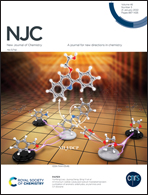Computational studies on nitrogen (N)-substituted 2,6-diphenylanthracene: a novel precursor of organic field effect transistor materials
Abstract
In recent years, experimental and theoretical studies show that nitrogen (N)-substituted π-conjugated semiconductor materials have improved their optical, charge-transfer and electronic performance and work efficiently in organic field-effect transistors (OFETs). To further investigate their applications, a new series of N-substituted 2,6-diphenylanthracene (2,6-DPA) derivatives have been designed. In this study, five derivatives of 2,6-diphenylanthracene were designed with one, two or three nitrogen atoms incorporated in 2,6-phenyl rings. The ground- and excited-state geometries, frontier molecular orbitals, and optical properties of these OFET precursors were calculated using density functional theory (DFT) and time-dependent DFT methods. Our results show that doping nitrogen atom into the 2,6-diphenylanthracene (2,6-DPA) linkage leads to the enhancement of the better planar geometry (the twist angle between phenyl ring and anthracene decreased by 1.6°–39.0°), lower energy gaps, larger electronic affinity (EA), and smaller electron reorganization energy, which make these precursors promising materials in OFETs. All N-substituted 2,6-DPA were observed as better hole-transfer materials. In addition, TD-DFT calculations show a characteristic peak in the range of 478–521 nm, indicating that tunable green emission could be achieved by appropriate chemical modification. The predicted structures and electronic properties can be a good starting point for the synthesis of N-substituted OFETs.



 Please wait while we load your content...
Please wait while we load your content...